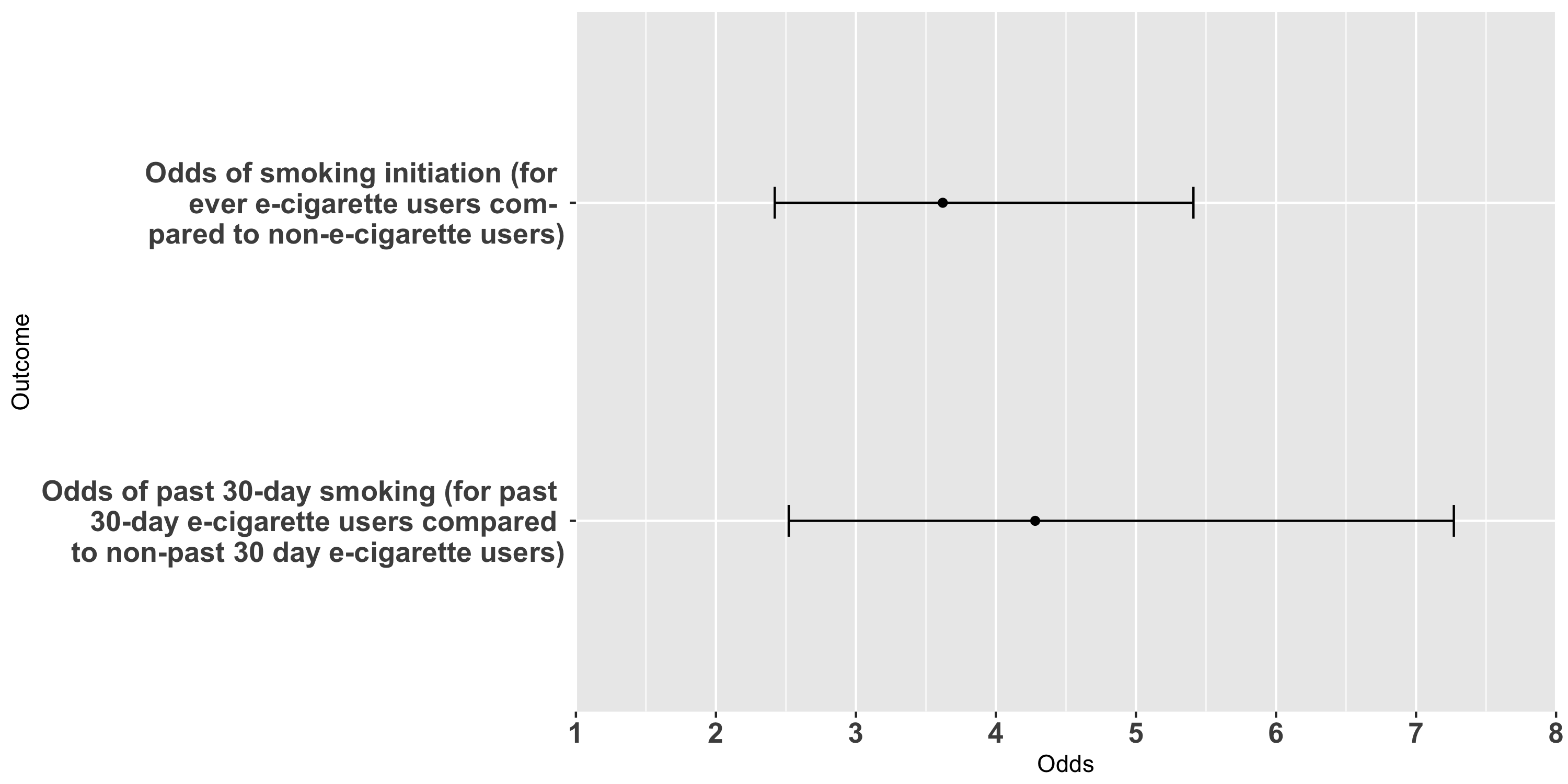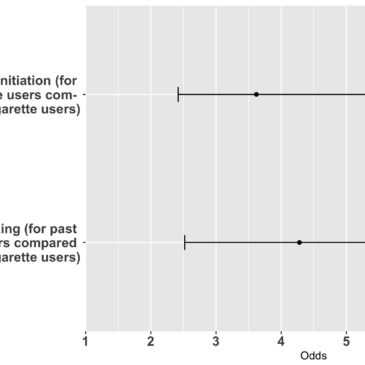There is some evidence that e-cigarettes help people quit smoking. However, they have also been linked to taking up traditional cigarette smoking, particularly among young people. Whether e-cigarettes represent a public health (or harm) could depend on the overall extent of this relationship. This week, ASHES reports on a study by Samir Soneji and colleagues that examined the association between youth e-cigarette use, smoking initiation, and past-month cigarette use. This review is part of our Special Series on Youth Risky Behavior.
What is the research question?
Are youth and young adults[1] who have used e-cigarettes more likely to smoke traditional cigarettes than those who haven’t used e-cigarettes?
What did the researchers do?
The authors examined the results of 9 longitudinal studies that either 1) examined smoking initiation between a baseline and follow-up period among participants who never smoked at baseline (7 studies); or 2) examined past 30-day cigarette use at follow-up among participants who had not smoked in the past 30 days at baseline (2 studies). Each study assessed at baseline whether participants had ever used e-cigarettes and reported whether that e-cigarette use was associated with either initiating cigarette smoking or smoking cigarettes in the past 30 days at follow-up. They also included other risk factors in their models.
What did they find?
Across all studies, the odds of smoking cigarettes at follow-up were 3.62 times greater for participants who had ever smoked e-cigarettes at baseline compared to those who had not. Comparably, the odds of past 30-day cigarette use at follow up were 4.28 times greater for participants who had smoked e-cigarettes in the past 30 days at baseline compared to those who had not. These relationships held even after accounting for risk factors such as age, sex, peer smoking, and sensation-seeking behaviors.
 Figure. Odds of smoking outcomes at follow-up periods for e-cigarette users compared to non-e-cigarette users. The circles in the figure represent estimates of the odds of smoking outcomes while the lines indicate the range of those estimates. Both estimates are statistically significant because they do not intersect with a value of one. Click image to enlarge.
Figure. Odds of smoking outcomes at follow-up periods for e-cigarette users compared to non-e-cigarette users. The circles in the figure represent estimates of the odds of smoking outcomes while the lines indicate the range of those estimates. Both estimates are statistically significant because they do not intersect with a value of one. Click image to enlarge.
Why do these findings matter?
This study highlights a potential side-effect of e-cigarettes: adolescents and young adults who use them are more likely to gravitate to traditional cigarette smoking than those who do not use e-cigarettes. The study’s findings also invite further questions. For example, do young e-cigarette smokers simply represent a population that is at higher risk for smoking, or does e-cigarette use itself push users towards traditional cigarettes? How many of the e-cigarette users who do not continue on to cigarette smoking would have been cigarette smokers if e-cigarettes weren’t available? Questions such as these need to be answered before we can fully understand the exact benefits (and/or harms) that e-cigarettes pose to society.
Every study has limitations. What about this one?
The attrition rates (percent of participants lost to follow-up) of the studies included in the meta-analysis varied considerably, but some were very high. For example, two studies had attrition rates over 50%. This can be problematic if participation at follow-ups was related to whether participants had taken up smoking. The studies relied on self-reports instead of observed behavior, meaning that some participants could have lied or experienced recall bias when reporting their smoking behaviors.
For more information:
The Center for Disease Control provides helpful information about e-cigarettes, youth smoking trends, as well as resources for quitting. For additional tools, please visit the BASIS Addiction Resources page.
— Timothy Edson
What do you think? Please use the comment link below to provide feedback on this article.
________________
[1] The ages of participants in the various studies ranged from 13 to 30. The average age across all studies was 18.57 while the average maximum age across all studies was 22.




